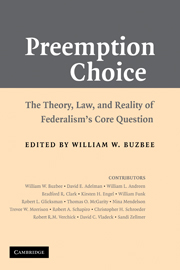Book contents
- Frontmatter
- Contents
- Contributors
- Acknowledgments
- Introduction
- Part I FEDERALISM THEORY, HISTORY, AND PREEMPTION VARIABLES
- Part II THE LAYERED GOVERNMENT NORM
- Part III JUDICIAL TREATMENT AND INTERPRETIVE CHOICE
- 6 Supreme Court Preemption Doctrine
- 7 When Congress Goes Unheard: Savings Clauses' Rocky Judicial Reception
- 8 Federal Preemption by Inaction
- 9 Process-Based Preemption
- 10 Preemption by Federal Agency Action
- Part IV PREEMPTION TALES FROM THE FIELD
- Index
8 - Federal Preemption by Inaction
Published online by Cambridge University Press: 07 July 2009
- Frontmatter
- Contents
- Contributors
- Acknowledgments
- Introduction
- Part I FEDERALISM THEORY, HISTORY, AND PREEMPTION VARIABLES
- Part II THE LAYERED GOVERNMENT NORM
- Part III JUDICIAL TREATMENT AND INTERPRETIVE CHOICE
- 6 Supreme Court Preemption Doctrine
- 7 When Congress Goes Unheard: Savings Clauses' Rocky Judicial Reception
- 8 Federal Preemption by Inaction
- 9 Process-Based Preemption
- 10 Preemption by Federal Agency Action
- Part IV PREEMPTION TALES FROM THE FIELD
- Index
Summary
Previous chapters show that courts sometimes find that the adoption and implementation of federal law preempts state law not only when Congress includes in a statute an explicit provision ousting state law but also when the courts discern the legislature's implicit intent to achieve that result. In a surprisingly large number of cases, the courts have declared state law to be preempted by federal legislative or regulatory action despite the presence in federal statutes of savings clauses whose objective is to preserve, rather than supersede, state law. But the preemption doctrine has the potential to sweep even more broadly. On occasion, even the federal government's failure to act has been deemed sufficient to preclude state governments from pursuing regulatory initiatives and to bar common law tort actions seeking redress for harms caused by a defendant's activities.
This chapter analyzes when inaction by either Congress or a federal regulatory agency has been and should be deemed preemptive of state law. Like all preemption questions, determinations of whether federal inactivity bars state action has important implications for the values reflected in our federal system of government. The unique aspect of the preemption through inaction conundrum is the likelihood that if a court finds that federal legislative or administrative failure to act preempts state regulation, the problems that attracted the attention of state government in the first place will wind up being completely unregulated.
- Type
- Chapter
- Information
- Preemption ChoiceThe Theory, Law, and Reality of Federalism's Core Question, pp. 167 - 191Publisher: Cambridge University PressPrint publication year: 2008

